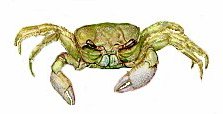Ocean Bottom
These fishes are most likely to be found on or near the bottom out at sea, either resting or swimming around. In addition, many of the types more often found in the rivers and inlets may be found out at sea.
Many of the types presented here are representative of entire families of similar related species. While some are closely related, others are not. These particular species are the most common in our area.
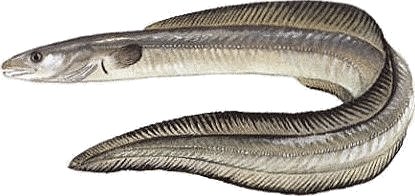
Conger oceanicus
Size
to 7 1/2 ft and 90 lbs., usually smaller
Description
The Conger Eel closely resembles the American Eel, Anguilla rostrata, but is distinguishable by its longer snout and the very large dorsal fin that originates much closer to the pectoral fins. The Conger is also larger, frequently attaining a weight of 10 to 20 pounds and a length of 5 to 7 feet. Its European cousin, Conger conger, is even more spectacular, occasionally tipping the scales at 130 pounds and measuring over 12 feet in length. The American Conger is gray above and white underneath. The dorsal and anal fins have broad black margins. Overall, the Conger appears much lighter than the freshwater eel, thus the common name Silver Eel. The species is distributed from Massachusetts to south Florida and in the Gulf of Mexico westward to Mississippi.
More: Conger Eel ...
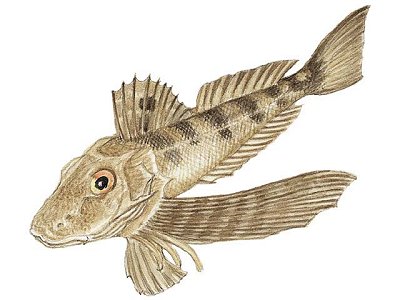
Prionotus carolinus
Size:
to 16"
Description:
Sea Robins are distinguished by the three free rays of the pectoral fins, with which the fish can actually walk across the bottom. They make frog-like croaking sounds when disturbed. Sea Robins have razor-sharp gill covers and spines, and are best left alone - there's not much meat on them anyway.
More: Northern Sea Robin ...
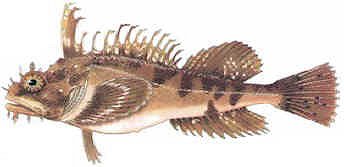
Hemitripterus americanus
Size
to 25" and 7 lbs.
Description:
The fleshy tabs around the head and ragged-looking dorsal fin are identifying characteristics of Scorpionfish like the Sea Raven. The eye is also very strange looking. These fishes prefer cooler waters and disappear when it warms up. Tropical and Pacific relatives including the introduced Lionfish have poisonous spines, but our species is harmless. Some people eat them, but I find them to be among the most interesting and obliging photo subjects in our waters.
More: Sea Raven ...
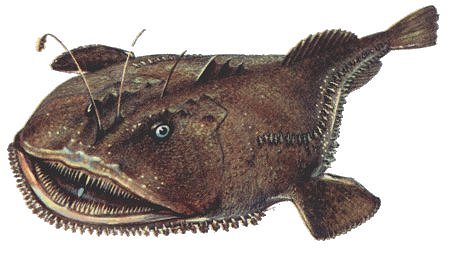
Lophius americanus
Size
to 48" and 50 lbs.
Description:
Also known as Headfish, these are a living nightmare in appearance, although they are actually rather docile, provided you don't get too close to the hungry end. Like alligators, they will snap at anything that comes within range, which makes for a number of hair-raising but amusing stories. The tails of these toothy monstrosities are excellent eating and are served in restaurants as "Monkfish" ( also known as "Headfish" and "All-mouth". ) They are extremely slimy. Females are larger than males. A related species in Europe grows to 100 lbs!
More: Goosefish ...
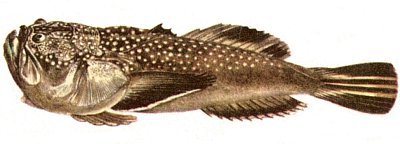
Astroscopus guttatus
Size
to 22" and 20 lbs.
Description:
Don't expect to see these fishes very often - they live buried in the sand, with just their eyes protruding. The eyes are directly atop the flat head, and the mouth is almost vertical. Of course, they are ambush predators. If you flush one from its hiding place, it will clumsily swim a short distance, and then rebury itself in just seconds. Stargazers are capable of producing weak electric currents from organs located behind the eyes. I doubt that it is enough to be dangerous to a diver, although it might be startling! Midshipmen are similar but smaller, with a continuous dorsal fin and luminescent spots instead of electrical organs.
More: Northern Stargazer ...

Macrozoarces americanus
Size
to 42" and 12 lbs.
Description:
Huge mouth with drooping lips. Anal and caudal fins continuous. Apparently, these are edible, and at times there is some effort on the part of commercial fishermen to catch them. Too ugly for my tastes, though. Pouts like rocky bottoms and structure, from water's edge down to 180 ft. Gregarious.
More: Ocean Pout ...

Pholis gunnellus
Size
to 12"
Description:
Very slippery, hence the name. Found in coastal waters and inlets, near shore.
More: Rock Gunnel ...
- Sea Basses & Porgies ...
- Blackfish & Cunner ...
- Cods & Allies ...
- Triggers, Puffers, & Sunfish ...
- Flounders ...
- Drums ...
- Ocean Bottom ...
- Baitfishes ...
- River & Inlet ...
- Pelagics ...
- Tropical Fishes ...
- Sharks - Inshore ...
- Sharks - Offshore ...
- Sharks - Dogfishes ...
- Skates & Rays ...
More: Marine Fishes ...
Fish
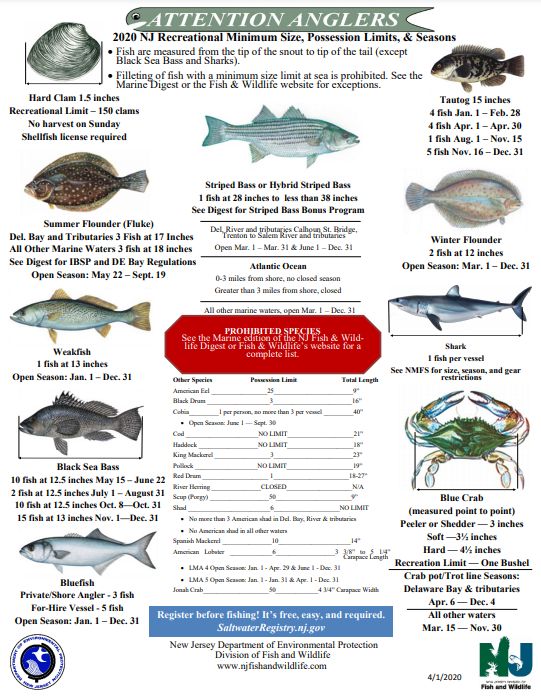
New Jersey now requires registration for saltwater fishing, including lobsters. Registration is free and can be done online at nj.gov/dep/saltwaterregistry.
This listing is for New Jersey waters only - if you cross into New York or Delaware, or Federal waters ( more than 3 miles offshore, ) you are subject to their regulations. Federal regulations supersede state regulations whenever stricter.
Lobster
More: Fishing Regulations ...

